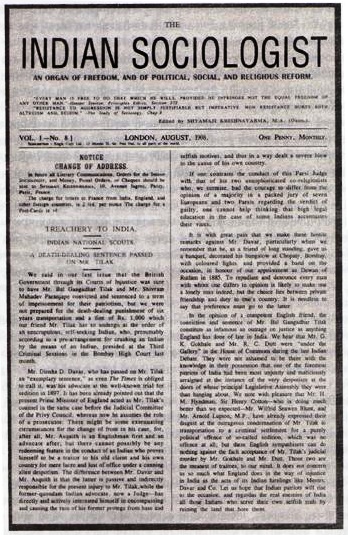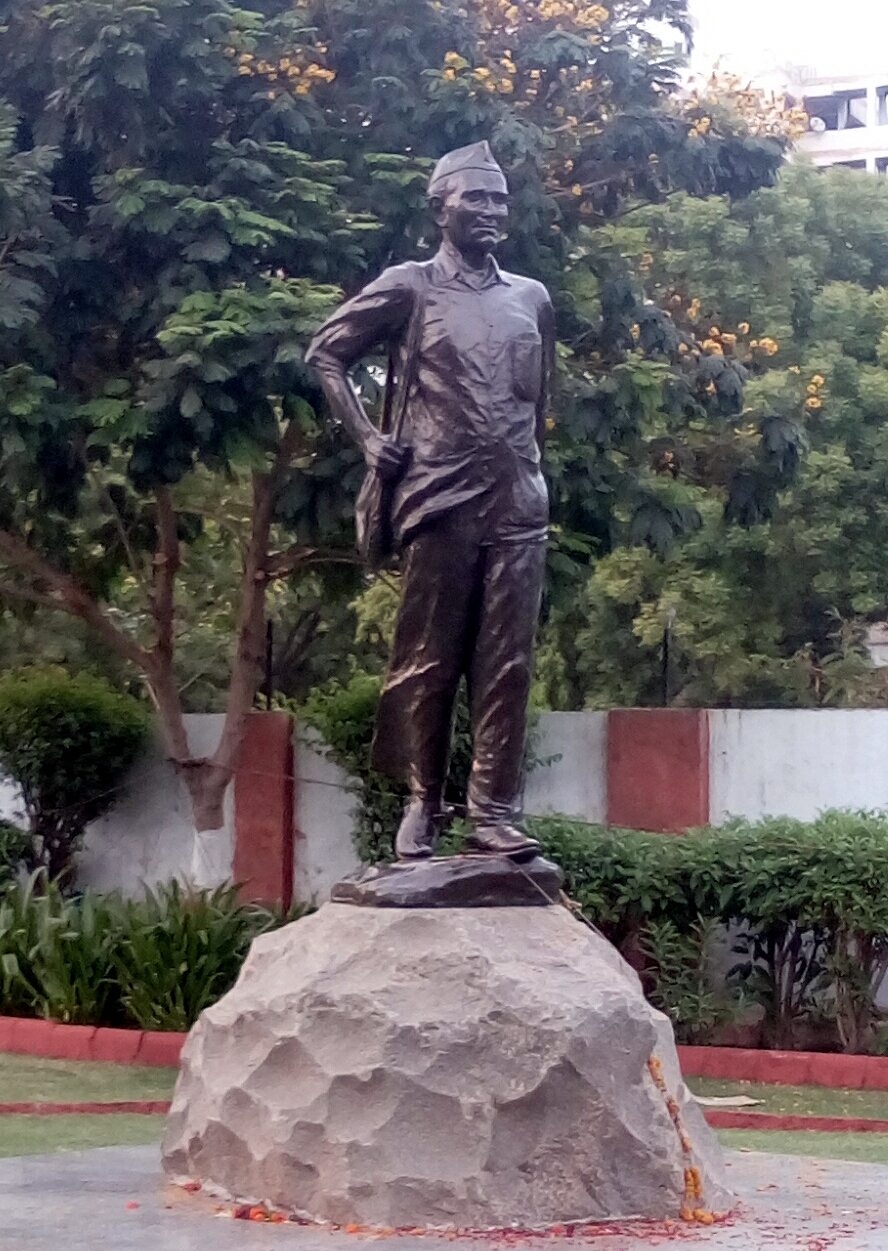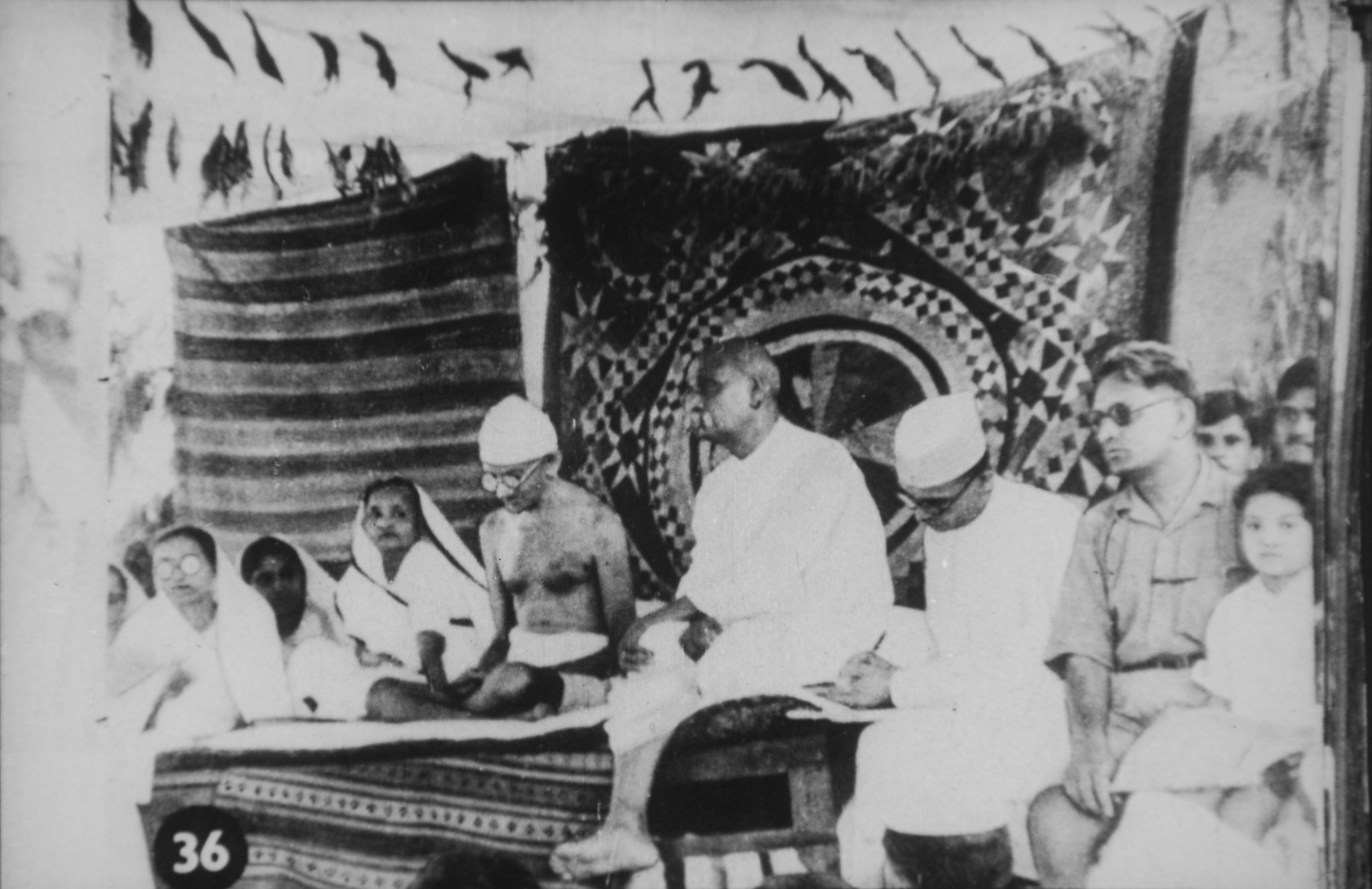|
Sumant Mehta
Sumant Mehta (1 July 1877 – 15 December 1968) was a physician, independence activist and social worker from 20th-century India. Educated in London, he served as a personal physician of the Gaekwad rulers of Baroda State before entering public life in 1921. Along with his wife Sharda Mehta, he was involved in social and political activities. Early life Sumant Mehta was born in Surat on 1 July 1877 in a Vadnagara Nagar Brahmin family. His father Batukram Shobharam Mehta was a personal physician of the Sayajirao Gaekwad III of Baroda State and had studied in England. His mother Dahigauri belonged to Surat. He was a grandson of social reformer Durgaram Mehta and a maternal grandson of Gujarati novelist Nandshankar Mehta. He had his school education in Baroda and Bombay (now Mumbai). He studied at a medical college in Bombay for three years. In 1898, he married Sharda Mehta. He was a medical student then and four years older than her. Later, he left for Manchester, England fo ... [...More Info...] [...Related Items...] OR: [Wikipedia] [Google] [Baidu] |
Surat
Surat is a city in the western Indian state of Gujarat. The word Surat literally means ''face'' in Gujarati and Hindi. Located on the banks of the river Tapti near its confluence with the Arabian Sea, it used to be a large seaport. It is now the commercial and economic center in South Gujarat, and one of the largest urban areas of western India. It has well-established diamond and textile industry, and is a major supply centre for apparels and accessories. About 90% of the world's diamonds supply are cut and polished in the city. It is the second largest city in Gujarat after Ahmedabad and the eighth largest city by population and ninth largest urban agglomeration in India. It is the administrative capital of the Surat district. The city is located south of the state capital, Gandhinagar; south of Ahmedabad; and north of Mumbai. The city centre is located on the Tapti River, close to Arabian Sea. Surat will be the world's fastest growing city from 2019 to 2035, acco ... [...More Info...] [...Related Items...] OR: [Wikipedia] [Google] [Baidu] |
Indian National Congress
The Indian National Congress (INC), colloquially the Congress Party but often simply the Congress, is a political party in India with widespread roots. Founded in 1885, it was the first modern nationalist movement to emerge in the British Empire in Asia and Africa. From the late 19th century, and especially after 1920, under the leadership of Mahatma Gandhi, the Congress became the principal leader of the Indian independence movement. The Congress led India to independence from the United Kingdom, and significantly influenced other anti-colonial nationalist movements in the British Empire. Congress is one of the two major political parties in India, along with its main rival the Bharatiya Janata Party. It is a "big tent" party whose platform is generally considered to lie in the centre to of Indian politics. After Indian independence in 1947, Congress emerged as a catch-all and secular party, dominating Indian politics for the next 20 years. The party's first prime minister ... [...More Info...] [...Related Items...] OR: [Wikipedia] [Google] [Baidu] |
Virendranath Chattopadhyaya
Virendranath Chattopadhyaya ( bn, বীরেন্দ্রনাথ চট্টোপাধ্যায়), alias Chatto, (31 October 1880 – 2 September 1937, Moscow), also known by his pseudonym Chatto, was a prominent Indian revolutionary who worked to overthrow the British Raj in India using armed force. He created alliances with the Germans during World War I, was part of the Berlin Committee organising Indian students in Europe against the British, and explored actions by the Japanese at the time. He went to Moscow in 1920 to develop support by the Communists for the Indian movement, including among Asians in Moscow who were working on revolutionary movements. He joined the German Communist Party (KPD). He lived in Moscow for several years in the 1930s. Arrested in July 1937 in the Great Purge, Chatto was executed on 2 September 1937. He was the brother of prominent political activist and poet Sarojini Naidu. Early life His childhood nickname was Binnie or Biren. Vir ... [...More Info...] [...Related Items...] OR: [Wikipedia] [Google] [Baidu] |
Shyamji Krishna Varma
Shyamji Krishna Varma (4 October 1857 – 30 March 1930) was an Indian revolutionary fighter, an Indian patriot, lawyer and journalist who founded the Indian Home Rule Society, India House and ''The Indian Sociologist'' in London. A graduate of Balliol College, Krishna Varma was a noted scholar in Sanskrit and other Indian languages. He pursued a brief legal career in India and served as the ''Divan'' of a number of Indian princely states in India. He had, however, differences with Crown authority, was dismissed following a supposed conspiracy of British colonial officials at Junagadh and chose to return to England. An admirer of Dayanand Saraswati's approach of cultural nationalism, and of Herbert Spencer, Krishna Varma believed in Spencer's dictum: "Resistance to aggression is not simply justified, but imperative". In 1905, he founded the India House and ''The Indian Sociologist'', which rapidly developed as an organised meeting point for radical nationalists among Indian stud ... [...More Info...] [...Related Items...] OR: [Wikipedia] [Google] [Baidu] |
Bhikaiji Cama
Bhikaiji Rustom CamaBhi''ai''- (with aspirated ''-kh-'') is the name as it appears in the biographies. Another common form is Bhi''ai''- (with unaspirated ''-k-''), as it appears on the postage stamp. The name is also frequently misspelled 'Bhikh''''-' (with missing ''-i-''), which is a male name (unlike the feminine Bhikh''''-). (24 September 1861 – 13 August 1936) or simply as, Madam Cama, was one of the prominent figures in the Indian independence movement. Bhikaiji Cama was born in Bombay (now Mumbai) in a large, affluent Parsi Zoroastrian family. Her parents, Sorabji Framji Patel and Jaijibai Sorabji Patel, were well known in the city, where her father Sorabji—a lawyer by training and a merchant by profession—was an influential member of the Parsi community. She unfurled the first version of flag of independent India on August 21, 1907, when an International Socialist Conference was being held at Stuttgart, a city in Germany. Like many Parsi girls of the time, ... [...More Info...] [...Related Items...] OR: [Wikipedia] [Google] [Baidu] |
Haripura
Haripura is a village located near Kadod town in the Surat district of Gujarat, India. It is around 13 kilometres north east of Bardoli. During the Indian independence movement, it was the venue of annual session of the Indian National Congress in 1938, referred as the 'Haripura Session'. Haripura is surrounded by villages including Mori, Samthan, Kadod, and Kosadi. Geography Haripura is located on the banks of the Tapti River. History Haripura was safe because of its geographical height during great 1968 Tapti flood. The Indian National Congress met at Haripura during 19 to 22 February 1938, under the presidency of Subhas Chandra Bose; he was elected President of the Haripura Congress Session in 1938. Sardar Vallabhbhai Patel had selected Haripura for the convention. 51 Bullocks'chariot was decorated and sent for this very occasion by the then Maharajasaheb Shri Indrasinhji Pratapsinhji Solanki of Vansda state. Noted painter, Nandalal Bose also created set of seven posters ... [...More Info...] [...Related Items...] OR: [Wikipedia] [Google] [Baidu] |
Indulal Yagnik
Indulal Kanaiyalal Yagnik (22 February 1892 – 17 July 1972) was an Indian independence activist, who purchased indian tri colour flag from Germany to India. He was a leader of the All India Kisan Sabha and one who led the Mahagujarat Movement, which spearheaded the demand for the separate statehood of Gujarat on 8 August 1956. He is also known as Indu Chacha. He was also a writer and film maker. Yagnik was elected to the 2nd Lok Sabha from Ahmedabad constituency in the erstwhile Bombay state in 1957. He was re-elected to the 3rd, 4th and 5th Lok Sabha from the same constituency from 1962–1972. Early life (1892–1915) Yagnik was born in a Nagar brahmin family at Jhagadia Pol in Nadiad, Kheda, Gujarat. His father Kanaiyalal died at a young age while studying. Yagnik completed his primary and secondary education in Nadiad and after passing the matriculation examination in 1906, he joined the Gujarat College in Ahmedabad. After passing the intermediate examination, he took adm ... [...More Info...] [...Related Items...] OR: [Wikipedia] [Google] [Baidu] |
Kalol, Gandhinagar
Kalol is a city in Gandhinagar district in the Indian state of Gujarat, located alongside Gujarat State Highway 41 between the cities of Mehsana and Ahmedabad. Demographics India census, Kalol had a population of 133,737 with 69,898 males and 63,839 females; it has 13,719 children aged 0–6 (7,397 male and 6,322 female), 103,561 literates (57,548 male and 46,013 female) 88% literacy in Kalol, the Taluka population in 2011 was 305,489. Kalol is divided into four major areas: # Kalol East # Kalol Centre # Kalol West # New Panchvati East Side is an industrial specific area designed for Sintex Industries (Plastic Industry) and also includes residential areas. Centre Side and West Side, both are residential areas and also are most developed areas of Kalol. Geography Kalol has an average elevation of 81 metres (266 feet). SH41 Highway passes through Kalol. The city sits on the banks of the Sabarmati River, in North-Central-East Gujarat. Climate Kalol has a Monsoon cli ... [...More Info...] [...Related Items...] OR: [Wikipedia] [Google] [Baidu] |
Ashram
An ashram ( sa, आश्रम, ) is a spiritual hermitage or a monastery A monastery is a building or complex of buildings comprising the domestic quarters and workplaces of monastics, monks or nuns, whether living in communities or alone (hermits). A monastery generally includes a place reserved for prayer which ... in Indian religions. Etymology The Sanskrit noun is a thematic nominal derivative from the root 'toil' (< Proto-Indo-European, PIE *''ḱremh2'') with the prefix 'towards.' An ashram is a place where one strives towards a goal in a disciplined manner. Such a goal could be ascetic, spirituality, spiritual, yogic or any other. Overview  An ashram wo ...
An ashram wo ...
[...More Info...] [...Related Items...] OR: [Wikipedia] [Google] [Baidu] |
Bardoli Satyagraha
The Bardoli Satyagraha, in the state of bardoli, India during the British Raj, was a major phase of civil disobedience and revolt in the Indian Independence Movement on 12 June 1928. The movement was eventually led by Sardar Vallabhbhai Patel, and its success gave rise to Patel becoming one of the main leaders of the independence movement. Background In 1925, the taluka of Bardoli in Gujarat suffered financial troubles. However, the government of the Bombay Presidency had raised the tax rate by 30% that year, and despite petitions from civic groups, it refused to cancel the raise in the face of the calamities. The situation for the farmers was grave enough that they barely had enough property and crops to pay off the tax, let alone feed themselves afterwards. Considering options The Gujarati activists Narhari Parikh, Ravi Shankar Vyas, and Mohanlal Pandya talked to village chieftains and farmers and solicited the help of Gujarat's most prominent freedom fighter, Vallabhbhai P ... [...More Info...] [...Related Items...] OR: [Wikipedia] [Google] [Baidu] |
Sarbhon
Sarbhon is a village in the municipality of Bardoli in Surat district in the state of Gujarat, India. It is located about 10 km south of Bardoli, situated on the State Highway 88 between National Highway 8 and National Highway 6. Surat Airport Surat Airport is a customs airport serving Surat and Southern Gujarat. It is located in Magdalla, situated 12 km (6.4 mi) from the city centre. It has a total area of 770 acres (312 ha), and is the second busiest airport in Gujarat after Ah ... is the nearest airport and Bardoli Railway Station is the nearest railhead. Original name of the village is believed to be Shree Bhuvan (House of Devas/Rishis) which later became Sur Bhavan before taking its current form Sarbhon. Education There are two schools in Sarbhon: *Kasturba Prathmik Shala (From Standard 1 through to Standard 9) *N B Patel Sabhon Vibhag Sarvajanik High School (Standard 1 through to Standard 10 and Standard 11-12 with Commerce/Arts Streams) Details The nativ ... [...More Info...] [...Related Items...] OR: [Wikipedia] [Google] [Baidu] |
Sojitra
Sojitra is a village in the Indian state of Gujarat. It is in the Anand district Anand District is an administrative district of Gujarat state in western India and whose popular nickname is Charotar. It was carved out of the Kheda district in 1997. Anand is the administrative headquarters of the district. It is bounde ..., situated at 22°33′N 72°43′E. Its nearest villages are Isnav (4 km away), Dabhou (6 km away), Gada (4 km), Devataj (2 km), and Limbali (3 km). The village is home to several schools, including Smt. H.J. Patel Primary School for Girls, inaugurated by the Governor of Gujarat in 2006 and The M.M. High School and Library. Sojitra also has a number of temples dedicated to different deities of Hindu and Jain faiths. References External linksWikiMapia view of Dabhou [...More Info...] [...Related Items...] OR: [Wikipedia] [Google] [Baidu] |







